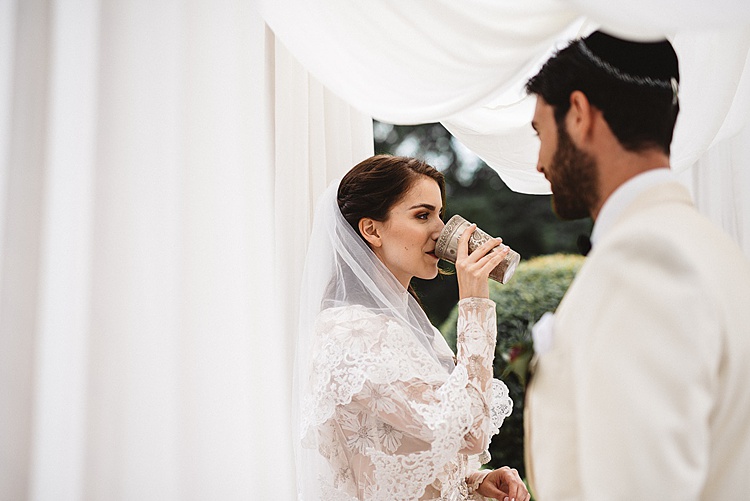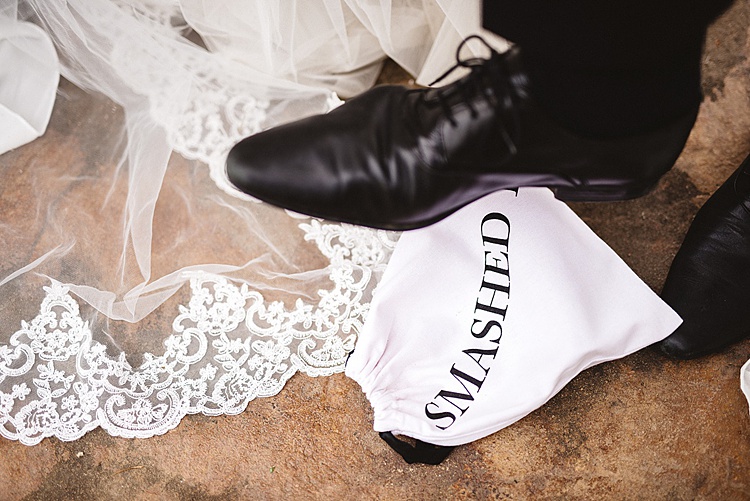
Styled by La Fête |Photo by Divine Day Photography
This is a guest post by Charlotte Ricard-Quesada, Founder & Creative Director of La Fête. She is passionate about helping her couples craft meaningful Jewish and interfaith Jewish weddings in the UK, Italy, France, Spain, and beyond. Today she’s channeling her wisdom into some great tips about how to plan a beautiful celebration that honors both of your backgrounds. Even if you and your partner are both Jewish, if you come from different cultural or international backgrounds lots of these tips will be relevant – so read on!
Love is a universal language, transcending borders, cultures, and religions. In an increasingly interconnected world, interfaith marriages are becoming more common, celebrating the beauty of diversity and the unity of love. While navigating these celebrations can be intricate, the result is a unique and deeply meaningful ceremony that honours both partners’ backgrounds. Here, we explore how to plan and execute an interfaith Jewish wedding that respects and celebrates the traditions of both partners.

Susie and Axel’s Jewish wedding, planned by La Fête |Photo by Dream Prod
Embracing Dual Heritage
The key to a successful celebration lies in understanding and respecting both traditions. This journey begins with open and honest conversations between the couple and their families. Discussing each person’s expectations, non-negotiables, and the elements they hold dear ensures that both faiths are represented and honoured. In many scenarios that I have dealt with, couples and families need to be as clear as possible from the start about their way of living their religion, and the rituals or traditions that are important for each one. Some families have a more paired-back vision of religious practice and this needs to be considered, without affecting the other party.

Rebecca and Emmanuel’s Jewish wedding, planned by La Fête |Photo by Juan Luis Morilla
Finding Common Ground
The beauty of any wedding lies in finding common ground and creating a ceremony that reflects the couple’s unique love story. Start by identifying shared values and themes that resonate with both traditions. For example, the importance of family, love, and community are universal concepts that can be beautifully woven into the wedding ceremony.

Rebecca and Emmanuel’s Jewish wedding, planned by La Fête |Photo by Juan Luis Morilla
Seeking Guidance
Consulting with clergy from both faiths can provide invaluable insights and help in blending the ceremonies seamlessly. Many rabbis and religious leaders have experience with interfaith weddings and can offer guidance on how to incorporate elements from both traditions respectfully. This collaborative approach not only enriches the ceremony but also provides a deeper understanding of each other’s faiths. Many times, when it has been interfaith weddings, I have had a rabbi and priest, or a rabbi and a vicar for example creating this beautifully unique ceremony.

Rebecca and Emmanuel’s Jewish wedding, planned by La Fête |Photo by Juan Luis Morilla
The Chuppah
A central element in a Jewish wedding, the chuppah represents the couple’s future home, open to guests and family. Including a chuppah in an interfaith ceremony is a beautiful way to honour Jewish tradition. Personalise the chuppah with meaningful decorations, such as family heirlooms or symbols from both faiths, to represent the union of two cultures.
Susie and Axel’s Jewish wedding, planned by La Fête |Photo by Dream Prod
Ketubah
The ketubah, or Jewish marriage contract, is a beautiful tradition that can be adapted for interfaith weddings. Couples can choose to include language that reflects their unique commitments and values, creating a personalized document that honours both faiths. Some interfaith couples opt for a secular or interfaith ketubah that highlights their mutual love and respect. Many times, my couples have chosen to remove or add slightly more modern terminology to the ketubah, especially relative to the wife’s role in the couple.

Rebecca and Emmanuel’s Jewish wedding, planned by La Fête |Photo by Juan Luis Morilla
Incorporating Both Traditions
To create a balanced and inclusive ceremony, alternate between elements of both faiths. For example, a Jewish blessing can be followed by a reading from the other partner’s religious text. Rituals such as the Sheva Brachot (seven blessings) can be complemented with blessings or traditions from the other faith, creating a harmonious blend of both worlds.

Styled by La Fête |Photo by Divine Day Photography
The Ring Exchange and Vows
The exchange of rings and vows is a universal symbol of love and commitment. Personalize this moment by including promises and sentiments that resonate with both partners’ beliefs. This can be an opportunity to highlight the values and aspirations that unite the couple, creating a deeply personal and meaningful exchange.

Rebecca and Emmanuel’s Jewish wedding, planned by La Fête |Photo by Juan Luis Morilla
Celebrating with Family and Friends
An interfaith Jewish wedding is not just a union of two individuals but also a merging of families and communities. Ensuring that all guests feel included and respected is crucial for a joyous celebration.

Susie and Axel’s Jewish wedding, planned by La Fête |Photo by Dream Prod
Educating and Involving Guests
Many guests may not be familiar with the traditions of both faiths. Providing a wedding program or guide that explains the significance of each ritual can enhance their understanding and appreciation. If elements are also in another language, translate them, it helps to keep all guests feeling included all along the way. If people feel excluded, their attention will waver and will start to chit chat, and no longer be present in such a special moment. Keep them involved and teach them about who you are and this unique blend you are creating before their very eyes. Additionally, involving family members from both sides in the ceremony, such as having them recite blessings or readings, fosters a sense of unity and inclusion.

Rebecca and Emmanuel’s Jewish wedding, planned by La Fête |Photo by Juan Luis Morilla
The Reception
The reception is a time for celebration, and incorporating elements from both cultures can make it a memorable experience. Consider blending traditional Jewish music and dances, such as the Hora, with music and customs from the other faith. The menu can also reflect both cultures, offering a diverse and inclusive culinary experience for all guests. I always recommend that some of the bridal party should be the ones to approach the non-Jewish guests to help teach them the dance moves if they so wish, making them feel included.

Styled by La Fête |Photo by Divine Day Photography
Symbolic Gestures
Small symbolic gestures can have a profound impact on making everyone feel welcome. Lighting a unity candle, a common practice in many Christian weddings, alongside the Jewish tradition of breaking the glass, symbolizes the coming together of two traditions. These moments create a sense of balance and mutual respect, highlighting the beauty of interfaith unity.

Susie and Axel’s Jewish wedding, planned by La Fête |Photo by Dream Prod
General Tips
It’s important to approach differences with respect and a willingness to learn. Understanding the significance of each tradition and why it matters to your partner leads to mutual respect and strengthens your bond.
Flexibility and compromise are key in planning an interfaith wedding. Some traditions might need to be adjusted or reimagined to fit the context of an interfaith ceremony. Maintaining open communication and being willing to adapt ensures that both partners feel heard and respected.
Seeking support from interfaith organizations or communities can provide valuable resources and guidance. Connecting with other interfaith couples who have navigated similar journeys can offer practical advice and emotional support.
So there you have it, with open communication, mutual respect, and a willingness to embrace each other’s heritage, an interfaith wedding becomes not just a union of two people, but a harmonious blending of two worlds. As you embark on this journey, remember that at the heart of it all is love – the universal force that transcends all differences and unites us in the most profound way.

